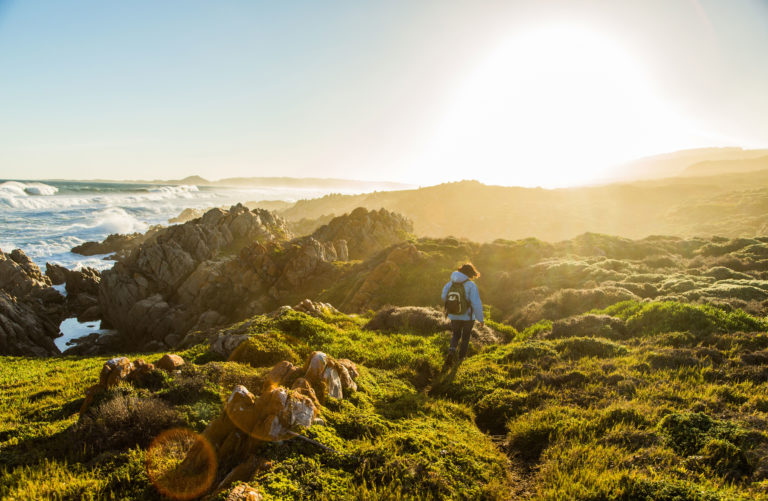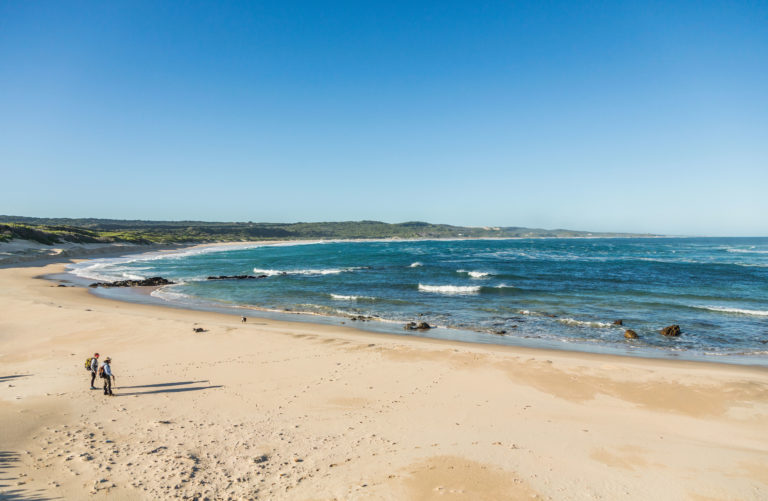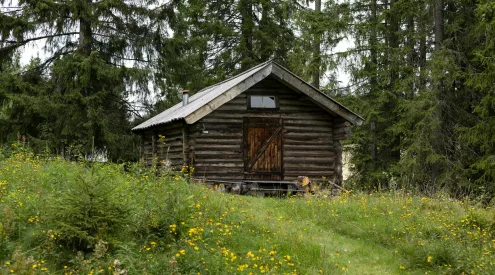For most of the 62-kilometre Chokka Trail, I dawdled at the back. It was a comfortable place to be. I was setting my own pace, savouring the solitude. I stopped often, bending down to weed out menacing little sticks of grass that were embedded in my socks and pricking my ankles. I spent time standing still looking up at the open sky, elated at being in nature, my lungs filled with the sea air carried by the wind and mingled with the heat of the sun. I sat down often to peel off my socks and shoes, shaking off millions of tiny grains of sand, while my fellow walkers became specks on the horizon. ‘Ha, I have this all to myself,’ I marvelled. And then I would catch sight of my colleague, Matt, strolling along behind me, his long-sleeved shirt billowing in the breeze, the sun striking shards of light over his sunnies and the metal on his camera as he looked through the lens, capturing the beauty of the Eastern Cape coastline.

Along this path from Oyster Bay, we could smell the presence of Cape clawless otters. Image credit: Matthew Sterne
We had met our walking companions as we shuttled from Cape St Francis to Oyster Bay to start the first day of the trail, which is an out-and-back, 18-kilometre walk along the coast to Thysbaai. After dumping our luggage at our night’s accommodation, Oyster Kaya, we collected our packed lunch and began to walk along empty shoreline footpaths and jeep tracks. We passed 2 000-year-old Khoisan fish traps (circular rock walls) only visible at low tide and the occasional ramshackle beach hut with hanging shell decorations, the kind you’d make over endless summer holidays.

Fossick at Thysbaai, which is known for its proliferation of fragile paper nautilus shells. Image credit: Matthew Sterne
On returning to Oyster Kaya, the sun was dipping, sea spray rolled in wetting my face, and golden beams criss-crossed the air over the land and sea. At this point, I was trying to remember the names of the six silhouettes charging ahead of me: the smiley woman kitted out in gaiters, uh … Lisa! And her friend Fran (also in gaiters) and Phyllis. All three had just summited Kilimanjaro. (I made a mental note to buy some of those walking poles they held.) And there’s Craig and the young lad, Gareth, with his pretty girlfriend, um, what’s her name? Oh yes, Ilse. They were all from Gauteng and very energetic.
Sitting by the fire that night, my body was weary but my spirits high. I was satisfied with life and excited about day two – the sand dunes. Valiant, one of the border collies which had come on our walk, snuck into my room to sleep. Comforted by the yawns of a tired, warm dog, I closed my eyes.
It was a fresh early morning as we set off. Banter filled the air as we hiked along a footpath in a conservation area. I was still smelling the lemon buchu I had picked earlier when we reached the top of a sand dune. Glancing up, waves of sand unfolded as far as the horizon and dense green coastal thicket lined its sides. I could feel a westerly wind nudging at my shirt. Awe-struck by the vastness in front of us, I joked, ‘We needn’t go to Namibia now, Matt.’
Looking back over our four-day journey, this was the prize of the Chokka Trail: 16 kilometres through the longest dune system in South Africa, known as the Sand River. Talk about experiencing something unique. This was it – the curves, shapes, patterns and shades of the sand were extraordinary. For the first three kilometres we climbed steep dunes and whooped for joy like excited children as we ran down the other side. Matt likened the landscape to freshly sculpted ice-cream. Yes, I concurred, just like caramel soft serve.

The steep descents in the dune corridor between Oyster Bay and Cape St Francis are a highlight of the trail and best tackled at top speed. Image credit: Matthew Sterne
Gradually the dunes settled into smaller contours and vegetation grew in the middle of this vast corridor, eventually giving way to a wetland. In sections, giant zebra-agate-snail shells lay scattered across the ground. On firmer areas they crunched beneath my boots, splintering into fragments.
The dunes we saw that day may never be seen again. ‘They change from week to week, modelled by wind and water, so mapping, marking or even describing this route is impossible,’ said Esti Stewart, our guide and founder (along with Maggie Langlands) of the Chokka Trail. She reminded me of a graceful gazelle, her long brown legs ploughing through the sand. Peace surrounded her as she strode ahead, showing us the way and pointing out things not to miss.
‘Look at this faint circle in the sand. It’s made by this strand of grass feathered by the wind. Be careful here, these are Khoisan implements dating back 2 000 years. I first saw them a year ago and every time I come back I see more pieces. This moving dune system continually uncovers and hides things, so maybe they’ll be hidden in a year’s time,’ she said.
Six hours passed before we eventually turned east, exiting the dunes late that afternoon. Civilisation appeared in the west, where we could see the giant rotating turbines at Kouga Wind Farm. As I took my final step out of the Sand River, I thanked Bokkie and Lindy Lombard, our hosts at Oyster Kaya. ‘Drink lightly tonight,’ they had warned us that first evening. ‘You’ve got a long hard walk tomorrow – you won’t make it if you have a hangover!’ I was also grateful for the juicy roast lamb Bokkie had cooked for our supper, and the breakfast. ‘How do you like your eggs?’ he’d asked each of us.
After the dune trek, the sight of my bedroom at Dune Ridge Country House that night was most welcome. Grandma’s huge feather bed was the focus, the floors were heated and the sherry complimentary. Restored by such luxury, day three to Cape St Francis was a 14-kilometre meander through coastal forests and thickets, and then past Mostertshoek, where there was a handful of inhabited holiday homes on the shoreline. At lunchtime, we lay in the sun like lizards on Mostertshoek Beach, which glistened with billions of tiny shells. Matt and I also collected pieces of green and blue sea glass for our colleague, Caro, back at the office. ‘You know how rare it is these days?’ she proffered prior to our departure.

From left: Phyllis Gainsford, Fran Nadar and Lisa Brett at Oyster Kaya. Image credit: Michelle Hardy
In the afternoon we visited Sanccob’s penguin sanctuary, on the southeastern-most tip of our continent. It’s marked by Seal Point Lighthouse, which booms a warning in foggy conditions. We had a short walk from here along the beach to Cape St Francis Resort for our third night’s accommodation. Busy with weekenders, we were jolted back to life away from nature’s peace and quiet.
Esti’s design of the final day couldn’t have been more different. On track to end in St Francis Village (12 kilometres away), we started our morning with a pristine beach walk that took us via Shark Point. Our mid-morning break was a delightful hour at Chokka Block Restaurant, where Clive Canter educated us on the ‘real’ taste and texture of calamari. With our bellies full, we still managed to wolf down lunch at St Francis Brewing Company (I was very impressed with my falafel) and sample its craft beers, all included in the cost.
To end the four days, we all boarded a boat for a sunset cruise through the St Francis canals and along the Krom River. A stroke of magic was that Esti included a final night’s accommodation at Brisan B&B. Anthony Miller and Janet Harrison cooked up a storm in this homely house and made sure we were warm (electric blankets). We were refreshed and ready to drive the long haul (eight hours) back to Cape Town early the next morning.
Walking loosens your brain, massages your thoughts and a kinship develops with others, even in silence. We shared the landscape, we shared meals and we shared many of our thoughts. I even shared my shrieks as Eric, Esti’s helpful husband and co-owner of the trail, catapulted my blisters into oblivion on day two with a shot of methialite.
I learnt to move a little faster during the trip but I also learnt that being at the back has its advantages – like following in other people’s footsteps through 16 kilometres of sand dunes.
The Chokka Trail
Duration 4 days
Type Guided for three days
Level Reasonably easy
Plan your trip
Getting there
Drive to Cape St Francis Resort (about an hour from PE) from where you’ll be shuttled to Oyster Bay, the start of the trail. Your car will remain at the resort in a safe spot.
Need to know
The minimum group size is four and maximum 12. The first day’s walk is unguided – do as much or as little of it as you like. Request an earlier start time if you want to do all 18 kilometres. The trail is fully catered but drinks are for your account (except the beer tasting).
Rate & Booking
From R5,860 per person for four days and four nights. 0738250835, chokkatrail.co.za






















